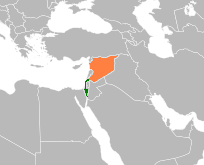Israel–Syria relations: Difference between revisions
add tourism |
water supply |
||
| Line 14: | Line 14: | ||
==Economic relations== |
==Economic relations== |
||
Since 2004, Israel has exported [[apple]]s to Syria through the [[Quneitra]] crossing. In 2010, some 10,000 tons of apples grown by [[Druze]] farmers in the [[Golan Heights]] were sent to Syria.<ref>[http://www.haaretz.com/hasen/spages/1153539.html Israeli trucks cross into Syria in annual 'apple invasion']</ref> |
Since 2004, Israel has exported [[apple]]s to Syria through the [[Quneitra]] crossing. In 2010, some 10,000 tons of apples grown by [[Druze]] farmers in the [[Golan Heights]] were sent to Syria.<ref>[http://www.haaretz.com/hasen/spages/1153539.html Israeli trucks cross into Syria in annual 'apple invasion']</ref>Israeli minister [[Ayoub Kara]] called for an agreement with Syria over the supply of water to towns in the Golan Heights. Today, ten percent of the water in the Israeli Druze town of [[Majdal Shams]] is supplied by Syria, from the Ein al-Toufah spring. This arrangement has been in place for 25 years. |
||
==Tourism== |
==Tourism== |
||
In 2010, the Israeli government authorized a pilgrimage to Syria by a group of 300 [[Druze]] citizens of Israel interested in visiting religious sites there.<ref>[http://www.ynetnews.com/articles/0,7340,L-3965496,00.html Israeli Druze to go on historic visit to Syria]</ref> |
In 2010, the Israeli government authorized a pilgrimage to Syria by a group of 300 [[Druze]] citizens of Israel interested in visiting religious sites there.<ref>[http://www.ynetnews.com/articles/0,7340,L-3965496,00.html Israeli Druze to go on historic visit to Syria]</ref> |
||
Revision as of 08:20, 19 October 2010
This article needs additional citations for verification. (October 2010) |
 | |
Israel |
Syria |
|---|---|
Israel-Syria relations refers to diplomatic and economic relations between Israel and Syria. Diplomatic ties have not been established, and the countries have fought four major wars, in 1948, 1967, 1973 and 1982.
History
Since the 1949 Armistice Agreements, relations between Israel and Syria have been characterized by periods of hostility; ceasefire talks, sometimes through intermediaries; and disengagement agreements, such as the 1974 Israeli-Syrian disengagement agreement. In 1949, an Israeli-Syrian peace treaty was negotiated with the short-lived Syrian government of Husni al-Za'im.
Prior to the 1967 Six Day War, intermittent hostilities centered on the Demilitarized Zones, water issues and shelling and infiltration from the Golan Heights. Since the war, the focus of negotiations has been "land for peace," in particular a demand that Israel return the Golan Heights to Syria in keeping with UN Security Council Resolution 242. Syria attempted to recover this territory in the Yom Kippur War, but was unsuccessful, only recovering a small part of it in the 1974 disengagement agreement. In the 1970s and 1980s, the conflict between Israel and Syria took place mainly on Lebanese soil.
The first high-level public talks aimed at a permanent resolution of the conflict between Israel and Syria were held at and after the mulitlateral Madrid Conference of 1991. Throughout the 1990s several Israeli governments negotiated with Syria's president Hafez Al-Assad. While serious progress was made, they were unsuccessful.
High points of hostility in the 2000s included the Ain es Saheb airstrike and Operation Orchard. During the 2006 Lebanon War, Syria threatened to enter the war on Hezbollah's side, and called the war a Hezbollah victory. Later, Turkey organized peace talks between the two countries, but Syria's anger about the Gaza War prompted it to withdraw.
In 2010, Syrian President Bashar al-Assad accused Israel of avoiding peace, and Syrian Foreign Minister Walid Muallem warned that in the event of a future war, Israeli cities would be targeted by Syrian missiles. Israeli Foreign Minister Avigdor Lieberman declared that Syria would lose another war with Israel, and not only would the Syrian Army be defeated, but Assad and his family would be forced from power. He advised Syria to let go of the demand for the Golan Heights, in the same way that it gave up on the Greater Syria dream.[1]
Economic relations
Since 2004, Israel has exported apples to Syria through the Quneitra crossing. In 2010, some 10,000 tons of apples grown by Druze farmers in the Golan Heights were sent to Syria.[2]Israeli minister Ayoub Kara called for an agreement with Syria over the supply of water to towns in the Golan Heights. Today, ten percent of the water in the Israeli Druze town of Majdal Shams is supplied by Syria, from the Ein al-Toufah spring. This arrangement has been in place for 25 years.
Tourism
In 2010, the Israeli government authorized a pilgrimage to Syria by a group of 300 Druze citizens of Israel interested in visiting religious sites there.[3]
See also
- Independent Israel–Syria peace initiatives
- Israel–Syria Mixed Armistice Commission
- The War over Water
References
Bibliography
- Cobban, Helena (2000). The Israeli-Syrian Peace Talks: 1991-96 And Beyond. Washington, D.C: United States Institute of Peace Press. ISBN 1-878379-98-4.
- Hinnebusch, Raymond A.; Drysdale, Alasdair (1991). Syria and the Middle East Peace Process. New York: Council on Foreign Relations Press. ISBN 0-87609-105-2.
{{cite book}}: CS1 maint: multiple names: authors list (link) - Rabinovich, Itamar (1991). The Road not Taken: Early Arab-Israeli Negotiations. Oxford [Oxfordshire]: Oxford University Press. ISBN 0-19-506066-0.
- Shlaim, Avi (2001). The Iron Wall: Israel and the Arab World. New York: W.W. Norton. ISBN 0-393-32112-6.


